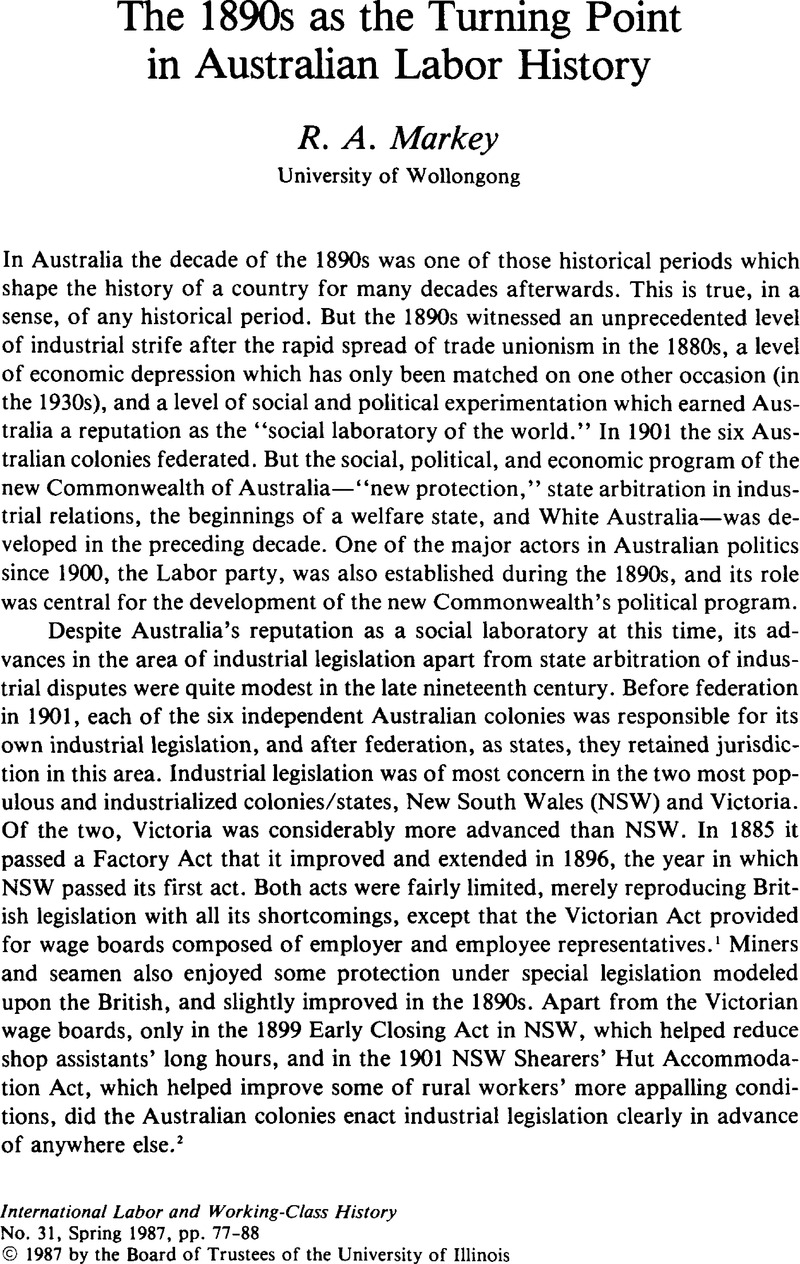No CrossRef data available.
Article contents
The 1890s as the Turning Point in Australian Labor History
Published online by Cambridge University Press: 16 December 2008
Abstract

- Type
- Review Essays
- Information
- Copyright
- Copyright © International Labor and Working-Class History, Inc. 1987
References
NOTES
1. Coghlan, T. A., Labour and Industry in Australia (1918; reprinted., Melbourne, 1969), 3:1484–86, 4:2096.Google Scholar
2. Markey, R., “Labour and Politics in New South Wales, 1880–1900,” (Ph.D. diss., University of Wollongong, 1983), 392–421.Google Scholar
3. The title used by Justice H. B. Higgins, the second President of the Commonwealth Conciliation and Arbitration Court, for his book on the subject (London, 1922).
4. See Hutson, J., From Penal Colony to Penal Powers (Sydney, 1966).Google Scholar
5. See, for example, O'Farrell, P. J., “The Australian Socialist League and the Labour Movement, 1887–1891,” Historical Studies, Australia and New Zealand 8 (05 1958):152–65.Google Scholar
6. McCarthy, P. G., “Employers, the Tarriff, and Legal Wage Determination in Australia, 1890–1910,” Journal of Industrial Relations 12 (1970):182–93CrossRefGoogle Scholar; and Hagan, J. “Employers, Trade Unions, and the First Victorian Factory Acts,” Labour History (Australia) 7 (11 1964):3–10.CrossRefGoogle Scholar
7. Markey, , “Labour and Politics,” Appendix 2.Google Scholar
8. Both the Australian and British figures are from Bain, G. S. and Price, R., Profiles of Union Growth: A Comparative Statistical Portrait of Eight Countries (Oxford, 1980), 37, 123.Google Scholar
9. Philipp, J., “1890— The Turning Point in Labour History,” Historical Studies, Australia and New Zealand: Selected Articles, 2nd ser. (Melbourne, 1967), 126–36Google Scholar; O'Connor, J., “1890—A Turning Point in Labor History: A Reply to Mrs. Philipp,” Historical Studies, Australia and New Zealand: Selected Articles, 137–49;Google ScholarPhilipp, J., “Some Comments on 1890—A Turning Point in Labour History,” Historical Studies, Australia and New Zealand: Selected ArticlesGoogle Scholar, 2nd ser. (Melbourne, 1967), 150.Google Scholar
10. Hagan, J., The History of the ACTU (Melbourne, 1981), 14, 45.Google Scholar
11. Spence, , Australia's Awakening, 94, 185.Google Scholar
12. Thompson, E. P., “History From Below,” Times Literary Supplement, 7 04 1966Google Scholar; Hobsbawm, E. J., “From Social History to the History of Society,” Daedalus 100 (Winter 1977): 20–45, and other articles in the same issue.Google Scholar
13. For a more detailed critique of traditional labor history in Australia, see Markey, R., “Revolutionaries and Reformists,” Labour History 31 (11 1976):86–95.CrossRefGoogle Scholar
14. For example, Turner, I., Industrial Labour and Politics: The Labour Movement in Eastern Australia, 1900–1921 (Melbourne, 1965), chap. 1Google Scholar; Ward, R., Australia (Sydney, 1965), chaps. 4–5.Google Scholar
15. Clark, C. M. H., “Re-writing Australian History,” in Australian Signpost, ed. Hungerford, T. A. (Melbourne, 1956)Google Scholar; Crawford, R. M., An Australian Perspective (Melbourne, 1960), 6Google Scholar; Martin, A. W., “The Whig View of Australian History,” seminar paper, Australian Association for Cultural Freedom, August 1964Google Scholar; Roe, M., “The Australian Legend,” Meanjin Quarterly 21 (1962):363–66Google Scholar. For an early reply to the critics, see Fitzpatrick, B., “The Origins of the People are Not in the Library,” Meanjin Quarterly 14 (1955):350–61Google Scholar; and “Counter-revolution in Australian Historiography?,” Meanjin Quarterly 22 (1963):197–213.Google Scholar
16. McQueen, H., A New Britannia: An Argument Concerning the Social Origins of Australian Radicalism and Nationalism (Ringwood, 1970)Google Scholar. See also Irving, T. and Berzins, B., “History and the New Left: Beyond Radicalism,” in The Australian New Left: Critical Essays and Strategy, ed. Gordon, R. (Melbourne, 1970), 66–94Google Scholar; and Macintyre, S., “Radical History and Bourgeois Hegemony,” Intervention 2 (11 1972).Google Scholar
17. McQueen, , A New Britannia, 236Google Scholar; and “Laborism and Socialism,” in Gordon, ed., The Australian New Left, 54, 57, 59, 65.Google Scholar
18. For example, see McQueen, , A New Britannia, 11–13Google Scholar; and the comments of an admirer of McQueen's, Rowley, K., in Arena 24 (1971):43Google Scholar: “If his analysis of the ALP is correct, to make socialist strategy dependent on the ALP is not to ‘risk corruption,’ but to commit suicide.”
19. Coleman, P., Australian Civilization (Sydney, 1962), 6.Google Scholar
20. For example, Mitchell, B., Teachers, Education, and Politics: A History of Organizations of Public School Teachers in NSW (St. Lucia, 1975)Google Scholar; Baker, J. S., Communicators and their First Trade Unions: A History of the Telegraphist and Postal Clerk Unions of Australia (Sydney, 1980)Google Scholar; Waters, F., Postal Unions and Politics (St. Lucia, 1978).Google Scholar
21. Macintyre, S., “The Making of the Australian Working Class: An Historiographical Survey,” Historical Studies 18 (10 1978):244–45CrossRefGoogle Scholar; Lawson, R., Brisbane in the 1890s: A Study of an Australian Urban Society (St. Lucia, 1973)Google Scholar, which is critical of the classical interpretation in the Queensland context, applies the Weberian concept of status in a much more thoroughgoing manner.
22. (Melbourne, 1941)Google Scholar. The one notable exception to these comments, which unfortunately is restricted to the 1880s and unpublished, is Fry, E. C., “The Condition of the Urban Wage Earning Class in Australia in the 1880s,” (Ph.D. diss., Australian National University, 1956)Google Scholar. Note that Gollan himself criticizes McQueen in the terms I have used. See “An Inquiry into the Australian Radical Tradition: McQueen's ‘New Britannia,’” Arena 24 (1971):32–38.Google Scholar




